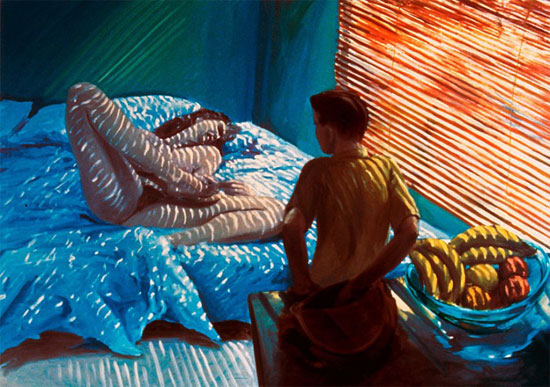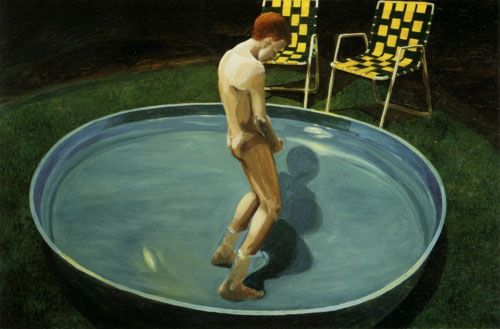The improbable literary hit of the summer is “Bad Boy,” a book written jointly by artist Eric Fischl and journalist Michael Stone. The book was intended to be a history of CalArts, a Southern California arts school conceived by Walt Disney to assemble the various arts under one roof, said roof to be next to the Hollywood Bowl. Disney merged the respected Los Angeles School of Music and the Chouinard Arts Institute announcing this at the premiere of “Mary Poppins.”
But “chim chim cher ree” wasn’t to be. Disney passed two years later and the project was taken on by the dean of the NYU School of the Arts, who injected unseemly New York career-orientation into the extended beatnik art culture of Southern California. It was a mix that would shake the art world shortly thereafter.
As this book progressed, the tale of this school instead became the story of its star student from the first 1970 class, Long Islander Eric Fischl, and took the name of one of his popular paintings.
The first part of this bildungsroman lingers on the relationship Fischl had with his mother, who was fond of a bit too many beverages. The amount of ink spent on Fischl’s captive relationship with a drunk indicates it defined his psyche and inoculated him from the subjectivity-avoidance art that was to come.
Ultimately his mother Janet Fischl would kill herself by driving into a tree at speed, and young Eric would puncture the happy veneer of his Port Washington childhood. Filmmakers dragged the suburbs into a clearing with “The Graduate” (1967) and “Alice Doesn’t Live Here Anymore” (1974), but no one had yet done so with painting.
John Gray once wrote, “What you feel you can heal”; in Fischl’s case, what he could feel he could sell. His uproarious suburban painting Bad Boy shows a nude female splayed on a bed while a youngster with a money shot turns his attention instead to purse-dive in the foreground. In Sleep Walker a young kid pees into a backyard wading pool in which he is standing. This is not “Leave It to Beaver.”

"Bad Boy" by Eric Fischl, 1981.

"Sleepwalker" by Eric Fischl, 1979.
In the roaring ’80s, these paintings and similar ones saw the 35-year-old Eric Fischl become a new category of person: a young art star. This social phenomenon rattled the old guard as young men of three decades, or in Jean-Michel Basquiat’s case two, were selling fresh paint for hundreds of thousands of dollars via the powerful Mary Boone gallery and others.
Prior to this phenomenon, artists assumed a vow of poverty; there were no “careers” or “prices,” just a life spent clawing up a steep slope hoping curators, critics, and museums deigned to notice their efforts. Suddenly there was money and the artists had it, someone had flipped the totem pole and the low man was waving from the top. “Hey I got mentioned in the Times,” burp, “Great, let’s order two bottles of Domaine Leroy Richebourg and you can read it to us,” laughter. Fischl imbibed freely with four-digit restaurant tabs and inhaled a portion of the bounty up his nose.
The book is sprinkled with short vignettes written by Fischl’s successful CalArts classmates: David Salle, Ross Bleckner, and Bryan Hunt, as well as non-classmate Julian Schnabel, who appears on point, kicking in the formalist door for the rest to follow. None of them can write, but it’s curious enough to hear them in their unedited voices.
The book is oddly choppy, but that seems to be its attraction: in speaking with other readers, I learned that they take away different things. A few non-artists found Fischl’s description of picture generation insightful, text this author breezed over, as an artist’s methods are about as consistent as the weather. Some found the decade-by-decade description of the last four of the art world instructive, and indeed it is accurate.
The chapter titled “Malaise 1990-1992” alone is worth the coinage. The writing turns professional at this point and I assume Stone is pecking and Fischl screaming. They describe this newly appeared work as the “detritus of adolescence” and its prime venue, the Jeffrey Deitch gallery, as “day care.” Indeed, artists Carry Liebowitz and later Mike Kelley exhibited stuffed animals in various rants about their childhood. Curator Nina Folkersma nailed it with her Amsterdam exhibition “Babies & Bambies” (1993), from the notice: “Babies, cuddly toys, teddy bears … slowly edged into contemporary art... as if they have been concocting a plan to invade the art world.”
This juvenilia gave way to a game of agitprops, what this writer has called “I Hate My Mom and My Room” art, that played out in soon-to-be-abandoned galleries, and by force, museums. Critic Robert Hughes leaned in and took one for the team with his “Culture of Complaint” (1994), but it played on. The collectors split, the economy turned turtle, and the value of new paintings dropped like an auctioneer’s hammer.
Later Fischl frets about his prices and is told by a terse dealer that he “didn’t make the cut.” Painful to hear, but also a stretch, as Fischl occupies that one hundred-thousandths strata of artists who still sell for six or seven figures. This is a feature that artists share: they look up, never down. Pablo Picasso died the wealthiest man in the world, but at the end he lamented that he “was not a great painter like a Titian or a Caravaggio.” Picasso searched other centuries for someone who bested him.
The balance of “Bad Boy” is a denouement from the punched out events that led to Fischl’s striking rise to become the leading artist of his generation. He unloads on the YBA (Young British Artists) and the formation of the uber-expensive work of the younger Jeff Koons and Damien Hirst, either of whom sells at a multiple of Fischl.
The irony here is thick: At the time Fischl made his rapid ascent, Andy Warhol, 20 years his senior, was painting portraits for one-fortieth the price of a Fischl, ditto for the developed work of sculptors Donald Judd and Bruce Nauman, artists who were dumbfounded at the plunder passing Fischl’s way. Pro forma, Fischl now assumes the position of the accomplished elder dishing on the next generation as feckless and over-compensated.
A subplot that winks now and then is Fischl’s touching relationship with his pretty wife, painter April Gornik, who in the early days had a mate afflicted with his family disease. Two chapters address sculptures Fischl made for American slaughters, the first the Oklahoma City bombing and later the much larger attack on New York City.
Improbably the nude in Oklahoma City was well received by a “Bible belt” community and inadvertently addressed rivalries between the police and fire departments. But in New York his Tumbling Woman was quickly removed from Rockefeller Center due to public outrage and Fischl tarred in the press. It’s still a puzzle why.
"Bad Boy” is immensely engaging and a fun read, it blends the compelling storytelling for which Eric Fischl is known with the smooth journalism of Michael Stone. It is at once a forthright autobiography and a raucous narrative history of the art world of the past 40 years.
____________________________________
ADDITIONAL WRITING BY JAMES CROAK:
"Stay Where You Are - The Art World is Coming To You"
"Art Review: Heads It's Tails"
________________________________________
© 2013 Hamptons Art Hub LLC. All rights reserved.



well written
Yes, I thought so too! James did a great job. Thanks, Steve.